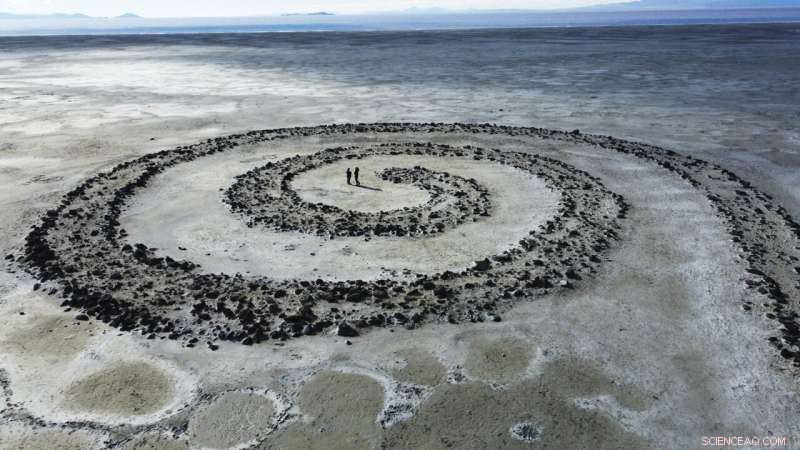
Il Great Salt Lake è mostrato sullo sfondo del terrapieno Spiral Jetty di Robert Smithson martedì 1 febbraio 2022, sulla sponda nord-orientale del Great Salt Lake vicino a Rozel Point nello Utah. L'anno scorso il Great Salt Lake ha eguagliato un minimo record di 170 anni e ha continuato a scendere, raggiungendo un nuovo minimo di 4.190,2 piedi (1.277,2 metri) in ottobre. Credito:AP Photo/Rick Bowmer
Il più grande lago naturale a ovest del Mississippi si sta riducendo ai livelli più bassi della storia, suscitando timori per la polvere tossica, il collasso ecologico e le conseguenze economiche. Ma il Great Salt Lake potrebbe avere dei nuovi alleati:i legislatori repubblicani conservatori.
La nuova esplosione di energia dal governo statale dominato dal GOP arriva dopo che i livelli dei laghi hanno recentemente raggiunto un punto basso durante una mega siccità regionale aggravata dal cambiamento climatico. L'acqua è stata deviata lontano dal lago per anni, tuttavia, per rifornire case e raccolti nello Utah. Lo stato in più rapida crescita della nazione è anche uno dei più aridi, con il più alto consumo di acqua domestica.
Quest'anno potrebbe vedere un grande investimento nel lago che è stato a lungo un ripensamento, con il governatore Spencer Cox che propone di spendere 46 milioni di dollari e il potente oratore della Camera che sostiene la questione. Ma alcuni temono che le idee che avanzano finora nella legislatura statale non vadano abbastanza lontano da fermare il disastro ecologico al rallentatore.
Una proposta affronterebbe l'uso dell'acqua nelle case e nelle aziende, misurando l'acqua all'aperto che è considerata una delle più economiche del paese. Un altro pagherebbe gli agricoltori per aver condiviso la loro acqua a valle, e un terzo dirigerebbe denaro dalle royalties per l'estrazione di minerali a beneficio del lago.
"Ho a lungo dato per scontato il lago. È sempre stato lì e ho pensato che sarebbe sempre stato lì", ha detto il presidente della Camera Brad Wilson in un vertice che ha convocato sulla questione. Ma l'apprendimento della precaria posizione del lago quest'estate lo ha lasciato terrorizzato. "Il Great Salt Lake è nei guai... Dobbiamo fare qualcosa."
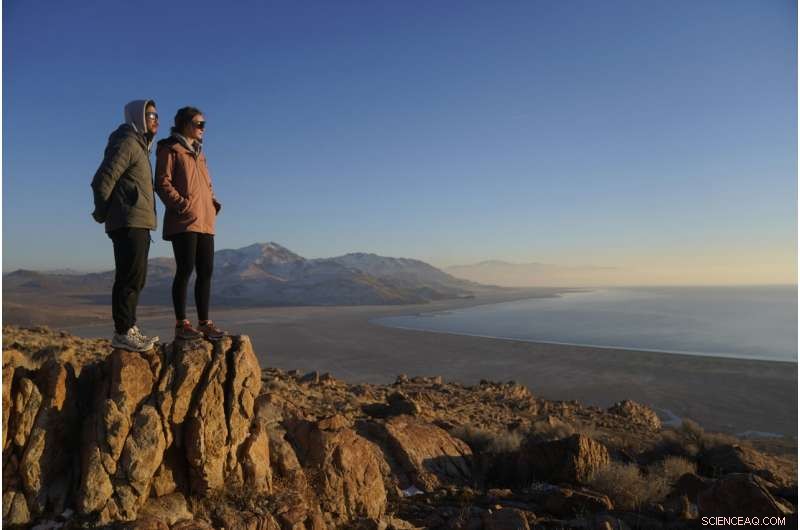
I visitatori dell'Antelope Island State Park vedono il bordo sfuggente del Great Salt Lake venerdì, 28 gennaio 2022, ad Antelope Island, Utah. Il più grande lago naturale a ovest del Mississippi si sta riducendo ai livelli più bassi della storia, suscitando timori per la polvere tossica, il collasso ecologico e le conseguenze economiche. Ma il Great Salt Lake potrebbe avere dei nuovi alleati:i legislatori repubblicani conservatori. Credito:AP Photo/Rick Bowmer
Il restringimento del lago pone seri rischi per milioni di uccelli migratori e per un'economia lacustre che vale circa 1,3 miliardi di dollari in estrazione di minerali, artemia salina e attività ricreative. Esistono anche rischi per la salute:l'enorme fondale asciutto del lago potrebbe inviare polvere di arsenico nell'aria che milioni di persone respirano.
"Il Great Salt Lake ha bisogno di alcuni salti per essere salvato. Non lo farà a piccoli passi", ha affermato Zach Frankel, direttore esecutivo dello Utah Rivers Council senza scopo di lucro. "Questi sono piccoli passi da compiere che avrebbero dovuto essere compiuti 20 anni fa."
Il lago ha subito un duro colpo l'anno scorso, con effetti particolarmente devastanti sui suoi microbialiti, la versione del Great Salt Lake di una barriera corallina. Le strutture a forma di fungo sono formate da stuoie di microbi pelose e verde intenso, che sono la base della catena alimentare del lago e il principale sostentamento per le artemia salina.
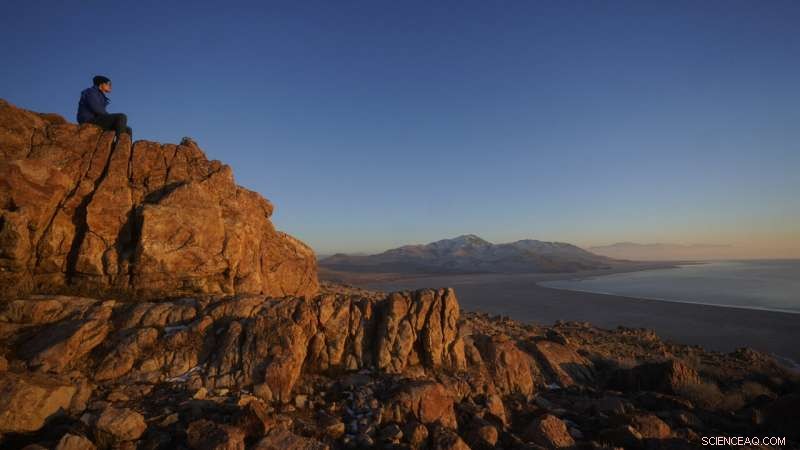
Un visitatore dell'Antelope Island State Park vede il bordo sfuggente del Great Salt Lake venerdì, 28 gennaio 2022, ad Antelope Island, Utah. Il più grande lago naturale a ovest del Mississippi si sta riducendo ai livelli più bassi della storia, suscitando timori per la polvere tossica, il collasso ecologico e le conseguenze economiche. Ma il Great Salt Lake potrebbe avere dei nuovi alleati:i legislatori repubblicani conservatori. Credito:AP Photo/Rick Bowmer
The shrimp both support a multimillion-dollar industry supplying food for fish farms and nourish millions of migrating birds whose massive flocks can show up on radar. The lake is also the nation's biggest source of magnesium and could soon provide lithium, a key mineral for renewable energy batteries.
But last year the lake matched a 170-year record low and kept dropping, hitting a new low of 4,190.2 feet (1,277.2 meters) in October. A significant portion of the microbialites were exposed to air, killing the vital microbes. The die-off will likely take years and years to repair even if they are fully submerged again, said Michael Vanden Berg, a state geologist.
And if the water levels continue to drop, the lake could get too salty for the edible microbes to survive, something that's already happened in the bright pink waters of the lake's north arm.
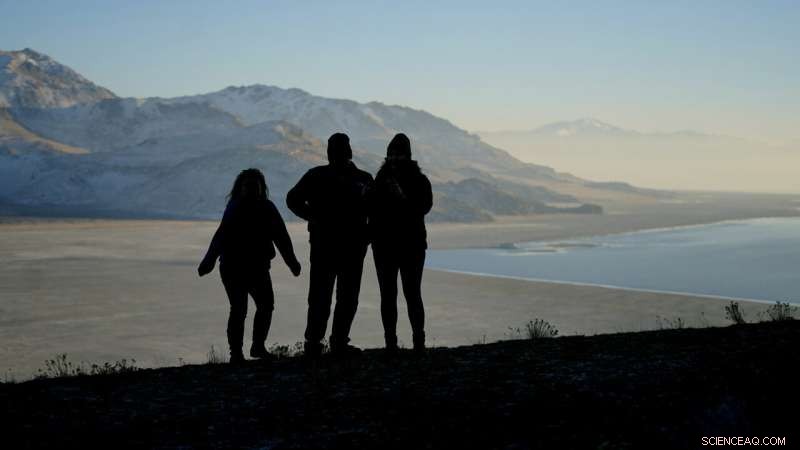
Antelope Island State Park visitors view a dry lake bed at the receding edge of the Great Salt Lake Friday, Jan. 28, 2022, at Antelope Island, Utah. The largest natural lake west of the Mississippi is shrinking past its lowest levels in recorded history, raising fears about toxic dust, ecological collapse and economic consequences. But the Great Salt Lake may have some new allies:conservative Republican lawmakers. Credit:AP Photo/Rick Bowmer
Still, Vanden Berg is cautiously optimistic for the south arm, where a portion of the green microbialites did survive last year's lake drop.
"It's bad but not catastrophic yet," he said. "There is still time to fix and mitigate the situation."
In some ways, the fix is simple:More water needs to flow into the lake.
But that's no small task in the state that grew by 18.4% over the past decade, to nearly 3.28 million people.
Utah has relatively inexpensive water overall. A 2015 state audit found Salt Lake City water prices were lower than almost every other city surveyed, including Phoenix, Las Vegas and Santa Fe.
But a subset of homes have access to especially low-price water—the cheapest in the nation, according to the Utah Rivers Council.
About 200,000 homes and businesses pay a flat fee for an entire season of irrigation water. It's called a secondary water system, made from converted agricultural supply in communities that are now largely suburban. Those account for a disproportionately large segment of the state's water use—and many of them are on the Great Salt Lake watershed, Frankel said.
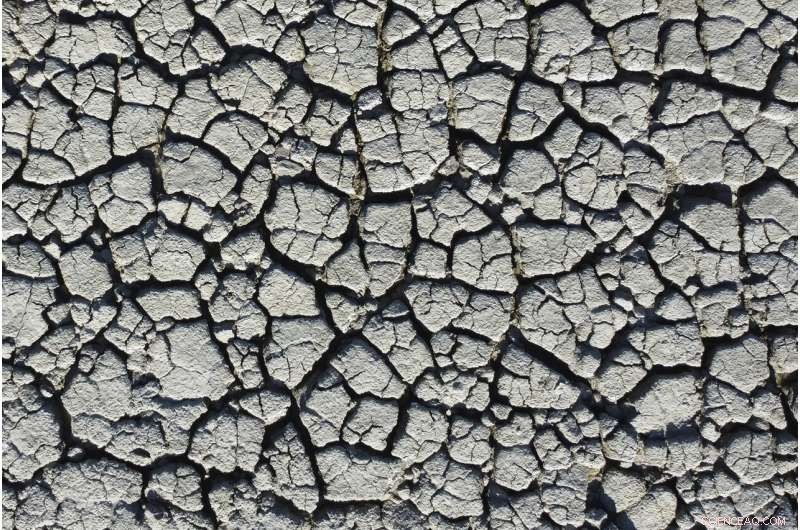
Cracked mud is shown at the Great Salt Lake Saturday, Jan. 29, 2022, on Antelope Island, Utah. Last year the Great Salt Lake matched a 170-year record low and kept dropping, hitting a new low of 4,190.2 feet (1,277.2 meters) in October. Credit:AP Photo/Rick Bowmer
"It's like an all-you-can-eat buffet," he said. While most people have a water meter on the side of their homes, usage isn't measured for secondary-water users.
But small-scale projects have shown that simply being aware of how much they're using makes people cut back by 20%, said GOP Utah Rep. Tim Hawkes.
There's been pushback to change the system before, and part of the reason is the per-meter cost of about $1,500, but the governor has backed spending about $250 million in federal pandemic relief money to install them.
The Utah Rivers Council would like to see people pay more for that water, but there's been little public discussion of that this year. Hawkes argues that even conserving 20% through awareness would dramatically increase the chances that the lake stays healthy.
This year is shaping up to be a wetter year than 2021, but that doesn't immediately translate to more water for the lake. First comes replenishing drinking water supplies. Then comes the lake.
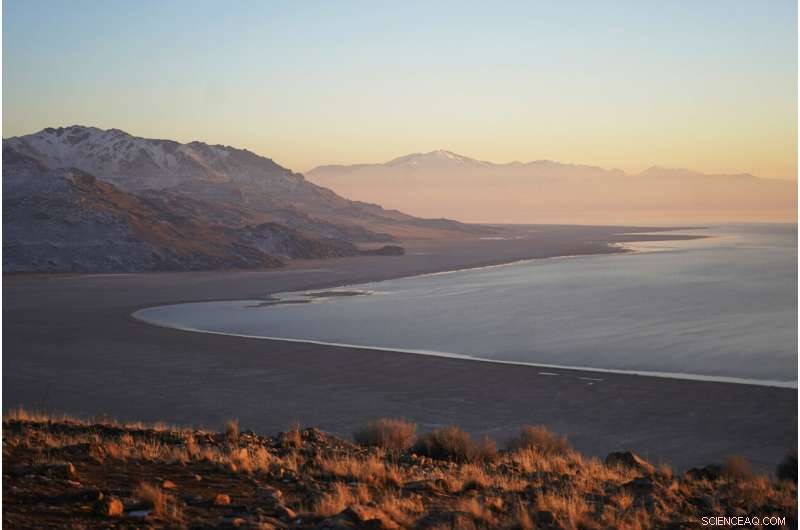
The beach shows the receding edge of the Great Salt Lake Friday, Jan. 28, 2022, at Antelope Island, Utah. The largest natural lake west of the Mississippi is shrinking past its lowest levels in recorded history, raising fears about toxic dust, ecological collapse and economic consequences. But the Great Salt Lake may have some new allies:conservative Republican lawmakers. Credit:AP Photo/Rick Bowmer
And homes and businesses aren't the only ones that need moisture. About 65% of the water on the Great Salt Lake watershed goes to agriculture. Farmers have a right to that water, and under historic laws they could lose the water they don't use.
"Right now, there's actually a disincentive for agriculture to conserve, or optimize, the water they're using," said Republican Rep. Joel Ferry.
He's sponsoring legislation that would let farmers get paid for water they let flow to the Great Salt Lake and other bodies. Because each farm is so much larger than the average home, even slight adjustments can have a major impact.
Under his plan, which has advanced at the state Legislature, it would be up to each farm to decide whether to sell water in a given year. The fund would also likely start with some federal pandemic money, and backers would hope to get donations as it continues.
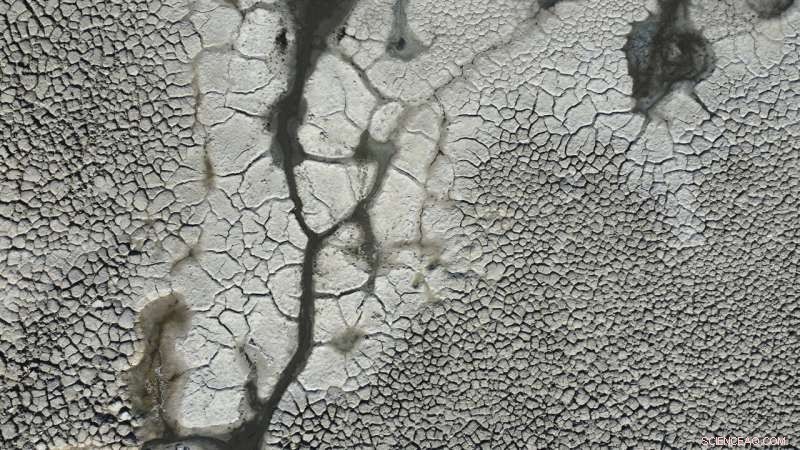
Water pools on cracked mud along the Great Salt Lake Saturday, Jan. 29, 2022, at Antelope Island, Utah. Last year the Great Salt Lake matched a 170-year record low and kept dropping, hitting a new low of 4,190.2 feet (1,277.2 meters) in October. Credit:AP Photo/Rick Bowmer
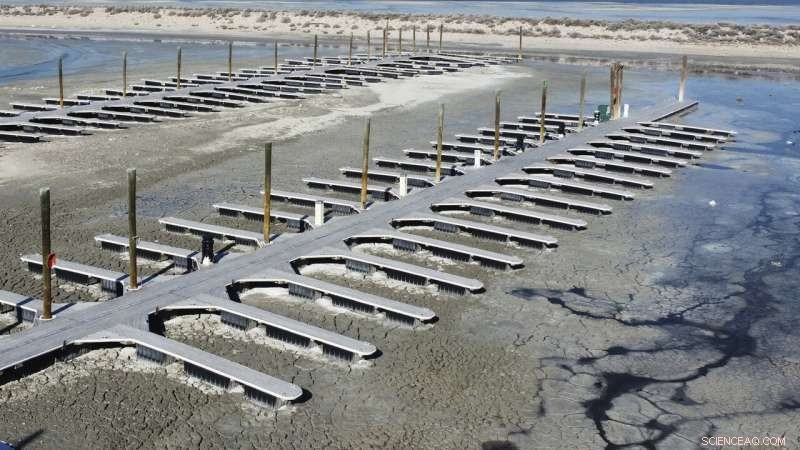
Mud surrounds the boat dock Saturday, Jan. 29, 2022, at Antelope Island, Utah. Last year the Great Salt Lake matched a 170-year record low and kept dropping, hitting a new low of 4,190.2 feet (1,277.2 meters) in October. Credit:AP Photo/Rick Bowmer

Sailboats sit in dry dock at the Great Salt Lake Marina Saturday Jan. 29, 2022, near Salt Lake City. The boats were removed last year to keep them from getting stuck in the mud. Last year the Great Salt Lake matched a 170-year record low and kept dropping, hitting a new low of 4,190.2 feet (1,277.2 meters) in October. Credit:AP Photo/Rick Bowmer
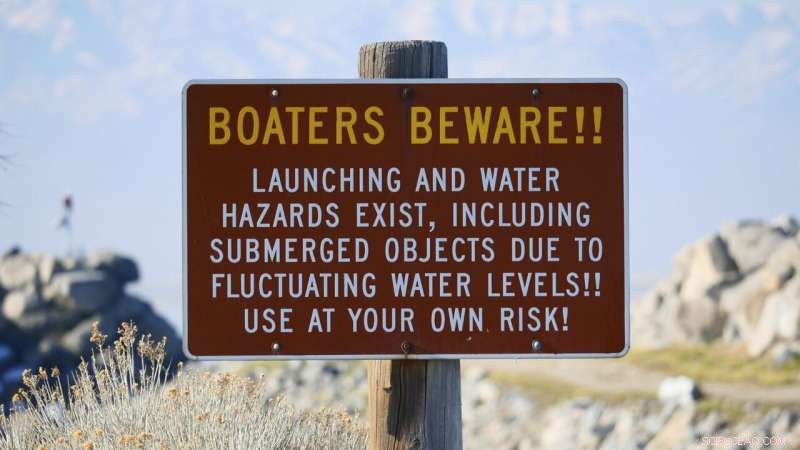
A "Boaters Beware!!" Sign is shown at the Great Salt Lake Marina Saturday Jan. 29, 2022, near Salt Lake City. The boats were removed last year to keep them from getting stuck in the mud. Last year the Great Salt Lake matched a 170-year record low and kept dropping, hitting a new low of 4,190.2 feet (1,277.2 meters) in October. Credit:AP Photo/Rick Bowmer
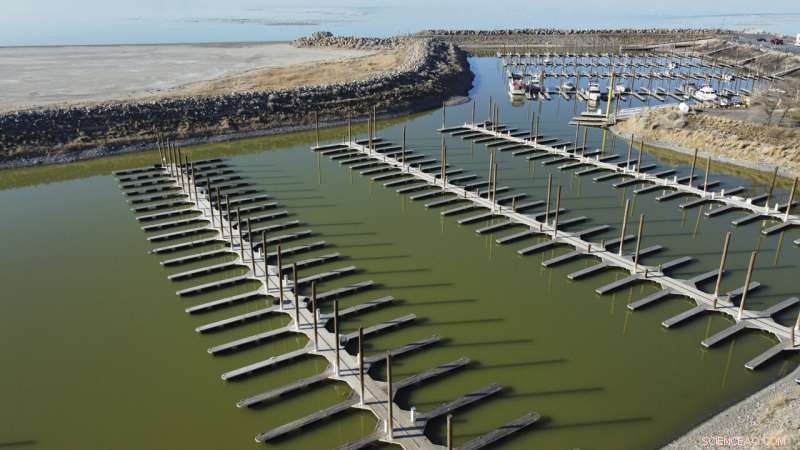
Docks are shown empty at the Great Salt Lake Marina Saturday Jan. 29, 2022, near Salt Lake City. The boats were removed last year to keep them from getting stuck in the mud. Last year the Great Salt Lake matched a 170-year record low and kept dropping, hitting a new low of 4,190.2 feet (1,277.2 meters) in October. Credit:AP Photo/Rick Bowmer
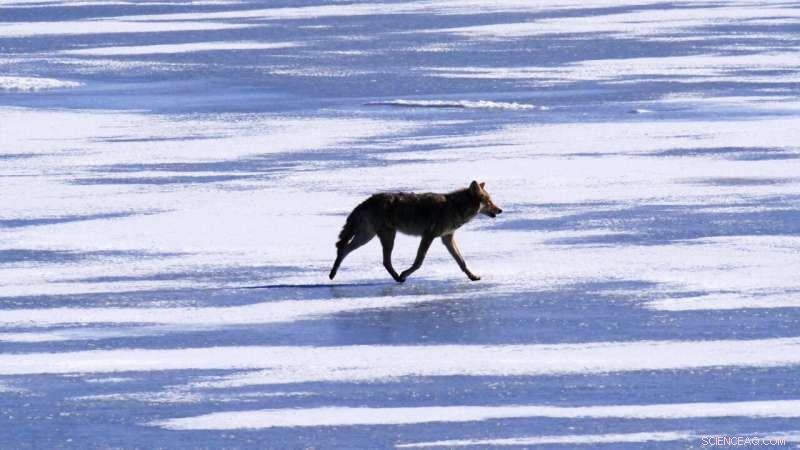
A coyote travels across ice formed on the Great Salt Lake Monday, Jan. 31, 2022, on Antelope Island, Utah. Millions of migrating birds stop at the Great Salt Lake, and American white pelicans nest there on what had long been a remote island. But now they are facing new challenges, including declining lake levels that have exposed a land bridge to the island, allowing coyotes and foxes to cross. Credit:AP Photo/Rick Bowmer
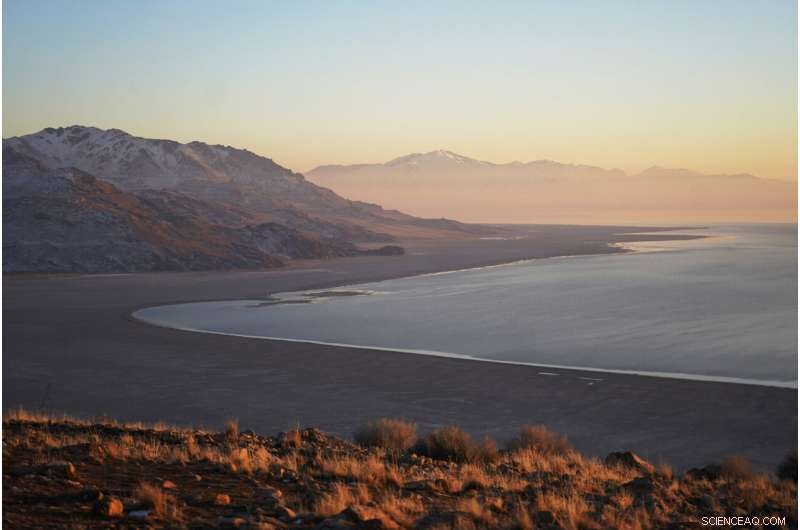
The beach shows the receding edge of the Great Salt Lake Friday, Jan. 28, 2022, at Antelope Island, Utah. The largest natural lake west of the Mississippi is shrinking past its lowest levels in recorded history, raising fears about toxic dust, ecological collapse and economic consequences. But the Great Salt Lake may have some new allies:conservative Republican lawmakers. Credit:AP Photo/Rick Bowmer
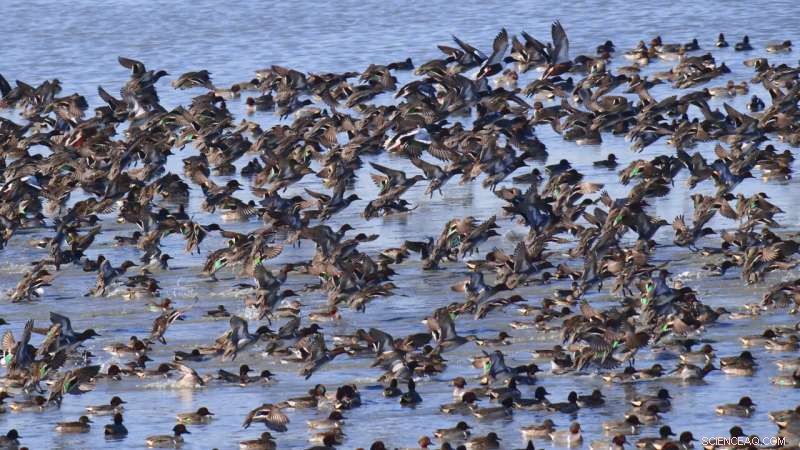
Migrating birds are shown at the Great Salt Lake Saturday, Jan. 29, 2022, in Antelope Island, Utah. The largest natural lake west of the Mississippi is shrinking past its lowest levels in recorded history, raising fears about toxic dust, ecological collapse and economic consequences. Credit:AP Photo/Rick Bowmer

The Great Salt Lake is shown behind a Bison Wednesday, Feb. 2, 2022, on Antelope Island, Utah. The largest natural lake west of the Mississippi is shrinking past its lowest levels in recorded history, raising fears about toxic dust, ecological collapse and economic consequences. Credit:AP Photo/Rick Bowmer
"This is going to be a slow start," said Ferry, who is a farmer himself. "We recognize there's a problem, and farmers want to be part of the solution. ... Ultimately the solutions to this are going to be expensive."
The costs of doing nothing may be even higher. The draining of California's Owens Lake as Los Angeles grew has cost billions. Overseas, the Aral Sea became as source of toxic dust after its water was diverted away by the former Soviet Union. Experts estimate a drying Great Salt Lake could cost Utah more than $2 billion every year.
"There's a real question about what happens next. Are we going to break through some critical thresholds here in the next little bit if we continue to go lower?" Hawkes said. "If we act now and we are thoughtful about it ... there's a good chance we can keep the lake healthy and happy—and us along with it."